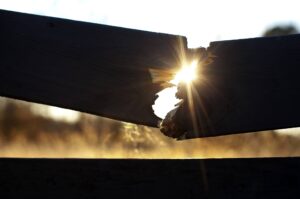
Isaiah 40:21-31 ; Mark 1:29-39
There are many stories of creation, coming from a variety of different cultural and religious traditions. We know best the two creation stories in Genesis. And we know them in a different way than we might know others, outside our religious tradition. But they are stories, like the others. And the reason we need such stories is simply because a story can contain greater, deeper truth sometimes than a whole pile of factual statements. There’s the old saying, a picture paints a thousand words. I think of stories as word pictures. They use words imaginatively to paint pictures that help us understand who we are and where we came from, and why we are here.
The two stories in Genesis about how the world came into being, the story in chapter one, about the seven days of creation, and the story in chapter 2, about Adam and Eve, both come from Jewish tradition. But they are not the only creation stories in Jewish tradition. There is another one I want to tell you.
You could start this story the same way such stories often start: In the beginning … When God began creating the heavens and the earth,
But here is where the story begins to differ, in that before the storytellers can tell us about the world that God created, they need to tell us something about the God who created it; the God who created everything in it, and humankind in God’s image – male and female, both, in God’s image.
Where was God before the creation of the world? God was everywhere. God was infinitely expansive, there was no place where he was not. God was so much in everyplace that there was no place for her to create. So God had to sort of withdraw himself, make a little space. God drew in her vast girth, and used that new empty space to create a world.
God created something new in the empty space she had cleared out. It was a new thing, but God put something of himself into it. A stream of the divine light poured into this new thing God made – the earth itself and the first human God made, called Adam, which means man, or human. The divine light shone through them.
But then, the storytellers say, the divine light proved to be too strong, too powerful, for these creations, and it destroyed them. A violent explosion occurred. Everything shattered apart in a million pieces, bits of the divine light, sparks, scattered everywhere. And this shattering, this separation, created an opportunity for evil to move into the world God created. It did, swarming everywhere.
But evil did not have a life-force of its own. It was a parasite. To survive, evil needed to capture some of the divine light, and so it did. With the divine light shattered into millions of tiny pieces it wasn’t that hard for evil to grab hold of a piece, borrowing its life energy. It is how evil continues to survive in the world even today, by attaching itself to good.
We might end this story the same way so many stories end, saying, “So that is how it came to be that evil co-exists in the world with good.” Or “That is how God’s good creation got spoiled, broken.” We can say that, but of course this is not the end of the story. It is only the beginning.
The story goes on to tell about the work of repairing this broken world, tikkun olam, the Hebrew phrase meaning the mending of the world. The way this world will be repaired is for all the fragments of goodness that are scattered around the world to be gathered back together. When all the God-pieces are put back together, evil will be gone, goodness and light will be restored. The world will, once again, be whole. There will be shalom.
According to the tradition, every time a human being performs a mitzvah, an act of obedience to God, a spark of divine light is restored to its place. Every good deed is like a stitch in the cosmic mending. Each act of love brings some healing to the world. Hence we seek to be obedient to God’s word not just for ourselves, but for the sake of God’s world.
It’s a story that says we are co-creators with God. We are partners with God in the repairing of this world. God depends on us to do our part to heal the creation. And, of course, we cannot do it without God. God shows us the direction to go and gives us the means with which to act.
The scriptures today are two kinds of healing stories, words of hope and encouragement to a people in exile. For all the people who have ever lived who felt like they are somehow separated from God, for everyone who ever felt like they had been abandoned by God, these stories from the prophet Isaiah and the gospel of Mark say no – that is not true. God is always with you.
As the prophet Isaiah said, “The Lord is the everlasting God, the Creator of the ends of the earth. He does not faint or grow weary; his understanding is unsearchable. He gives power to the faint, and strengthens the powerless…those who wait for the Lord shall renew their strength.” This powerful and awesome God is always with you; God will never leave you.
As the gospel of Mark tells us, Jesus went throughout Galilee, proclaiming the message in their synagogues and casting out evil; bearing the message: God is always with you. God will never leave you. God is at work, even now, repairing the world.
This is what I tell the children more than anything else: God is always with you. God will never leave you. They need to hear it; you need to hear it. A people in the midst of pandemic need to know: God is always with you; God will never leave you. The whole world needs to hear it.
Because the world is broken. The goodness of God has been shattered, scattered in pieces all over, pieces of divinity so small it is sometimes hard to recognize them. But they are there, because God is there, ready to do mending and caring and healing work wherever it is needed. And God calls us to be a part of that work too.
Wait. As the prophet Isaiah says, wait. Listen. Devote yourself to prayer and good deeds, as Jesus himself did. Speak words of hope, sharing the message of Jesus Christ, about the healing of the world, wherever you are. Be a part of the work of restoring the world, one piece at a time. Tikkun Olam.
